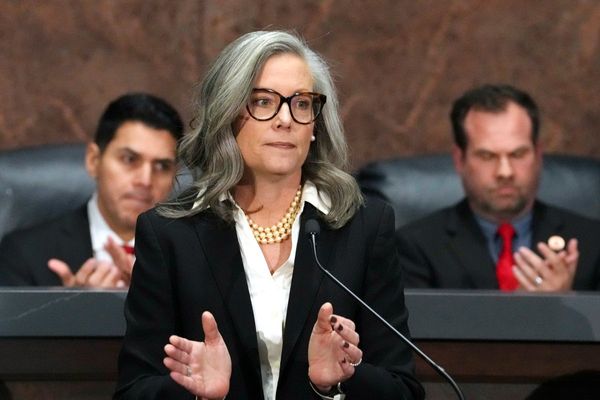
As spiraling Omicron cases overwhelm Hong Kong’s health system, officials doubled down on their zero-Covid strategy on Tuesday by commandeering thousands of apartments and hotel rooms to isolate infected residents.
Wards at public hospitals have begun to overflow, with reports of children being turned away as pediatric isolation beds ran out. Despite the strain, just a fraction of those being treated or isolated were in critical condition, and Hong Kong officials urged Covid-19-positive residents—previously subject to immediate hospitalization regardless of symptoms or vaccination status—to avoid emergency rooms if their symptoms are mild.
Officials acknowledged that they were struggling to keep up with testing suspected cases across the city. There were more than 1,600 confirmed new infections reported on Tuesday. While this was lower than Monday’s record 2,071 tally, 5,400 more suspected cases awaited verification.
While much of the world continues to open up despite the global spread of the coronavirus, Hong Kong Chief Executive Carrie Lam told residents to prepare for further tightening of what are already among the world’s most stringent anti-Covid-19 restrictions. The containment measures have so far failed to stop accelerating infections of the less deadly Omicron strain.
The pace and severity of the outbreak, the biggest since the pandemic began, has outgrown the city’s capacity, Mrs. Lam said. “We cannot surrender to the virus. This is not an option," she said.
Hong Kong is adhering to Beijing’s goal of eliminating infections, though it has for now ruled out a citywide lockdown of the kind that has been used by authorities on the mainland to stamp out outbreaks. The city has called for help from mainland authorities to boost testing and build medical facilities to counter the Omicron wave.
On Tuesday, the city’s hospital authority said more than 4,100 patients were in isolation or treatment for Covid-19, eight of them in critical condition. Eight people have died in the latest wave of infections.
Experts said the figures likely don’t reflect the full extent of cases in Hong Kong because of the backlog in testing capacity, with the highly contagious Omicron variant quickly overwhelming the government’s ability to stick with its longstanding policy of isolating positive cases in hospital wards and quarantining close contacts.
The government will secure 3,000 apartments at newly built public housing estates and up to 10,000 hotel rooms to confine the growing number of cases, officials said. They will also designate seven new clinics for treatment.
Wards at the city’s public hospitals were operating at close to full capacity on Monday night, official data show, with more than half a dozen hospitals either at or exceeding their limits. Images of patients at one swamped hospital waiting outside on gurneys for treatment quickly spread through social media, heightening public concerns.
“We have to move to a model in which we are promoting home isolation, which is essentially the de facto strategy at this point," said Karen Grépin, an associate professor at the University of Hong Kong’s School of Public Health. She cautioned that it isn’t clear that the city has the infrastructure to keep such large numbers of people isolated at home. “Without proper support and care, it’s going to be very dangerous," she said.
Hong Kong’s No. 2 leader, John Lee, traveled across the city’s northern border to Shenzhen over the weekend to discuss support measures from the mainland Chinese government. Though the specific nature of the cooperation hasn’t been revealed, officials said Hong Kong would form task forces that would coordinate with mainland officials on virus control.
Roughly a month into its fifth wave of Covid-19 infections, Hong Kong has quickly become the center of the worst outbreak in Chinese territory since the coronavirus emerged in central China more than two years ago. The wave of mostly Omicron infections halted a monthslong stretch of virtually no locally transmitted cases, dashing hopes that the Asian financial hub would soon reopen its borders with mainland China and eventually with the rest of the world.
Though officials have instituted the city’s tightest virus-control measures to date in recent weeks, they said no citywide lockdown is planned. Current restrictions include a ban on dining out after 6 p.m., closures of gyms, bars, hair salons and other establishments and halts on flights to nine countries including the U.S. and the U.K. A rule barring the unvaccinated from supermarkets and shopping malls starts Feb. 24.
Hong Kong officials have locked down neighborhoods and housing estates where outbreaks have been especially acute, but haven’t instituted harsher measures that have successfully tamped outbreaks in the mainland. Many experts doubt whether the city has the infrastructure to maintain more comprehensive lockdowns.
Another obstacle for city leaders remains the low vaccination rate among elderly residents, who are most vulnerable to severe Covid-19 symptoms. Overall, 75% of residents have received two doses of a vaccine, but for those in their 70s the figure stands at 55%, while for those 80 and above it is 26%.
This story has been published from a wire agency feed without modifications to the text







